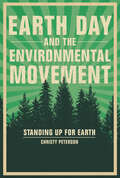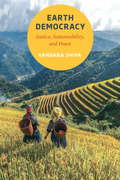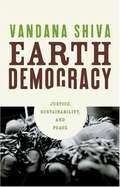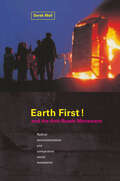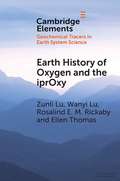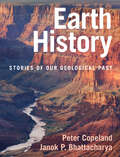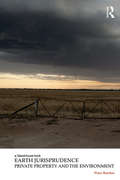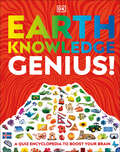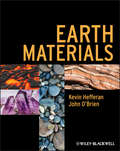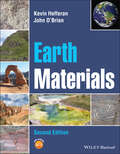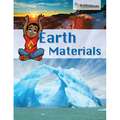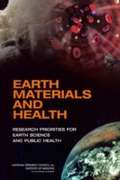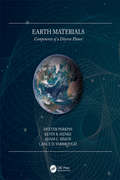- Table View
- List View
Earth Day and the Environmental Movement: Standing Up for Earth
by Christy PetersonOn April 22, 1970, an estimated twenty million people held in a teach-in to show their support for environmental protections. This new celebration, Earth Day, brought together previously fragmented issues under the same banner. It was the largest nationwide event ever, and lawmakers took notice. But one day didn't change everything. Fifty years after the first Earth Day, climate change remains a dire concern. The divide between political parties continues to widen, and environmental policy has become an increasingly partisan issue. The spread of disinformation has also made climate change a debatable idea, rather than scientific fact. A new generation of advocates continue the fight to make environmental policy a top priority for the United States and for nations around the globe. "Our goal is an environment of decency, quality, and mutual respect for all human beings and all other living creatures . . . Our goal is a decent environment in its broadest, deepest sense."—Gaylord Nelson, Earth Day founder "[T]he potential consequences are certainly major in their impact on mankind. Now is the time. The research is clear. It is up to us now to summon the political will."—Robert Walker, US Representative from Pennsylvania "There's always a perception that business and industry and conservation groups . . . don't agree on anything. . . . [W]e can come together to demonstrate that we might be looking at it from different sides, but the outcome is the same."—Doug Miell, consultant, Georgia Chamber of Commerce
Earth Democracy
by Vandana ShivaWorld-renowned environmental activist and physicist Vandana Shiva calls for a radical shift in the values that govern democracies, condemning the role that unrestricted capitalism has played in the destruction of environments and livelihoods. She explores the issues she helped bring to international attention--genetic food engineering, culture theft, and natural resource privatization--uncovering their links to the rising tide of fundamentalism, violence against women, and planetary death. Struggles on the streets of Seattle and Cancun and in homes and farms across the world have yielded a set of principles based on inclusion, nonviolence, reclaiming the commons, and freely sharing the earth's resources. These ideals, which Dr. Shiva calls "Earth Democracy," serve as an urgent call to peace and as the basis for a just and sustainable future.From the Trade Paperback edition.
Earth Democracy: Justice, Sustainability, and Peace
by Vandana ShivaBoldly confronting the neoconservative Project for the New American Century, world-renowned physicist and activist Vandana Shiva responds withEarth Democracy, or, as she prophetically names it, "The People's Project for a New Planetary Millennium. " A leading voice in the struggle for global justice and sustainability, here Shiva describes what earth democracy could look like, outlining the bedrock principles for building living economies, living cultures and living democracies. Starting from the initial enclosure of the commons--the privatization of six million acres of public land in eighteenth-century Britain--Shiva goes on to reveal how the commons continue to shrink as more and more natural resources are patented and fenced. Accompanying this displacement from formerly accessible territory, she argues, is a growing attitude of disposability that erodes our natural resources, ecological sustainability and cultural diversity. Worse, human beings are by no means safe from this assignment of disposability. Through the forces of neoliberal globalization, economic and social exclusion work in deadly synergy to perpetrate violence on vulnerable groups, extinguishing the lives of millions. Yet these brutal extinctions are not the only trend shaping human history. Forthright and energetic, Vandana Shiva updates readers on the movements, issues and struggles she helped bring to international attention--the genetic engineering of food, the theft of culture and the privatization of natural resources--and deftly analyzes the successes and new challenges the global resistance now faces. From struggles on the streets of Seattle and Cancun and in homes and farms across the world has grown a set of principles based on inclusion, nonviolence, reclaiming the commons and freely sharing the earth's resources. These ideals, which Shiva calls "earth democracy," will serve as unifying points in our current movements, an urgent call to peace and the basis for a just and sustainable future.
Earth Education: A New Beginning
by Steve Van MatreEarth education aims to accomplish what environmental education set out to do, but didn't: to help people improve upon their cognitive and affective relationship with the earth's natural communities and life support systems, and begin crafting lifestyles that will lessen their impact upon those places and processes on behalf of all the earth's passengers. If you care about the health of our troubled planet, then you should read what this internationally known educator has to say about how we lost a whole generation of teachers and leaders and what you can do to help them find their way again.
Earth Emotions: New Words for a New World
by Glenn A. AlbrechtAs climate change and development pressures overwhelm the environment, our emotional relationships with Earth are also in crisis. Pessimism and distress are overwhelming people the world over. In this maelstrom of emotion, solastalgia, the homesickness you have when you are still at home, has become, writes Glenn A. Albrecht, one of the defining emotions of the twenty-first century.Earth Emotions examines our positive and negative Earth emotions. It explains the author's concept of solastalgia and other well-known eco-emotions such as biophilia and topophilia. Albrecht introduces us to the many new words needed to describe the full range of our emotional responses to the emergent state of the world. We need this creation of a hopeful vocabulary of positive emotions, argues Albrecht, so that we can extract ourselves out of environmental desolation and reignite our millennia-old biophilia—love of life—for our home planet. To do so, he proposes a dramatic change from the current human-dominated Anthropocene era to one that will be founded, materially, ethically, politically, and spiritually on the revolution in thinking being delivered by contemporary symbiotic science. Albrecht names this period the Symbiocene.With the current and coming generations, "Generation Symbiocene," Albrecht sees reason for optimism. The battle between the forces of destruction and the forces of creation will be won by Generation Symbiocene, and Earth Emotions presents an ethical and emotional odyssey for that victory.
Earth Environments: Past, Present And Future
by David Huddart Tim A. StottComprehensive coverage of the whole Earth system throughout its entire existence and beyond Complete with a new introduction by the authors, this updated edition helps provide an understanding of the past, present, and future processes that occur on and in our Earth—the fascinating, yet potentially lethal, set of atmospheric, surface, and internal processes that interact to produce our living environment. It introduces students to our planet’s four key interdependent systems: the atmosphere, lithosphere, hydrosphere and biosphere, focusing on their key components, the interactions between them, and environmental change. The book also uses geological case studies throughout, in addition to the modern processes. Topics covered in the Second Edition of Earth Environments: Past, Present and Future include: an Earth systems model; components systems and processes; atmospheric systems; oceanography; surface and internal geological systems; biogeography; and aspects of Earth's record. The book also discusses the impact of climate and environmental change in a final chapter that draws together Earth's systems and their evolution, and looks ahead to potential future changes in Earth’s environments. Updated to include all the major developments since 2008 Features research boxes containing summaries based on recent key journal articles Includes a companion web site containing multiple choice revision quizzes for students, PowerPoint slides for lecturers, useful links, and more Presents further reading for each topic so that students can build their knowledge base to underpin their own undergraduate research project/dissertation Offers additional case studies in each chapter for enhanced reader understanding Earth Environments: Past, Present and Future is an excellent text for undergraduates in geosciences, environmental science, physical geography, natural hazards, and ecology.
Earth Erupts: Volcanoes (Turbulent Planet)
by Mary ColsonThis book explains what happens when a volcano violently explodes. Find out why volcanoes form and how to survive when the Earth Erupts.
Earth First! and the Anti-Roads Movement: Radical Environmentalism And Comparative Social Movements
by Derek WallEarth First! is one of the most controversial and well known green movements in the world and the driving force behind the anti-road campaigns of the 1990s, made famous by sabotage tactics. Detailed accounts of major anti-road campaigns both in the UK and internationally are included, describing confrontations at Twyford, Newbury, Glasgow, the Autobahn in Germany, and information on the international spread of the Earth First! movement, with details of campaigns in Australia, Ireland, Germany, France, Holland and Eastern Europe. Earth First! and the Anti-Roads Movement traces the origins of the movement and the history of anti-roads activism in Britain since the 1880s. Radical EF! organisers describe how they took on their green activist identity, why they launched both EF! and the anti-roads movement, and their experiences of dramatic protest. Exposing the tensions between EF! and other green activists, they explain the political and economic influences on and the culture and politics of protest. Showing how green social and political theory can be linked to practical struggles for environmental and social change, Derek Wall investigates key topics of political and sociological interest in Britain and the World today. This is an authoritative account based on passionate and lyrical autobiographical accutns form activists blended with a strong theoretical grounding.
Earth First:Anti-Road Movement
by Derek WallFirst published in 1999. Routledge is an imprint of Taylor & Francis, an informa company.
Earth History Resources
by University of California at Berkeley Lawrence Hall of ScienceNIMAC-sourced textbook
Earth History of Oxygen and the iprOxy (Elements in Geochemical Tracers in Earth System Science)
by Ellen Thomas Zunli Lu Wanyi Lu Rosalind E. RickabyHow oxygen levels in Earth's atmosphere and oceans evolved has always been a central question in Earth System Science. Researchers have developed numerous tracers to tackle this question, utilizing geochemical characteristics of different elements. Iodine incorporated in calcium carbonate (including biogenic) minerals, reported as I/Ca, is a proxy for dissolved oxygen in seawater. Here we review the rationale behind this proxy, its recent applications and some potential future research directions.
Earth History: Stories of Our Geological Past
by Peter Copeland Janok P. BhattacharyaProviding a new approach to Earth history, this engaging undergraduate textbook highlights key episodes in the history of our planet and uses them to explain the most important concepts in geology. Rather than presenting exhaustive descriptions of each period of geological time, this conceptual approach shows how geologists use multiple strands of evidence to build up an understanding of the geological past, focusing on exciting events like the extinction of the dinosaurs and the formation of the Grand Canyon and the Himalaya. Beginning with an introduction to geology, tectonics, and the origin of the Universe, subsequent chapters chronicle defining moments in Earth history in an accessible narrative style. Each chapter draws on a variety of sub-disciplines, including stratigraphy, paleontology, petrology, geochemistry, and geophysics, to provide students who have little or no previous knowledge of geology with a broad understanding of our planet and its fascinating history.
Earth Hour: A Lights-Out Event for Our Planet
by Nanette HeffernanClick flashlights, light lanterns, and get ready to turn electric lights out to celebrate Earth Hour! Wherever you are, you can help our planet.Kids around the world use electric energy to do all kinds of things--adults do, too! From cleaning the clothes we play in, to lighting up our dinner tables, to keeping us warm and toasty when the weather is cold, electricity is a huge part of our lives. Unfortunately, it can also have a big impact on our planet.Earth Hour--a worldwide movement in support of energy conservation and sustainability--takes place each March and is sponsored by the World Wildlife Fund for Nature (WWF). During Earth Hour, individuals, communities, and businesses in more than 7,000 cities turn off nonessential electric lights for one hour. Across each continent--from the Eiffel Tower to the Great Wall of China to the Statue of Liberty--one small act reminds all of us of our enormous impact on planet Earth.
Earth Jurisprudence: Private Property and the Environment (Law, Justice and Ecology)
by Peter D. BurdonThe idea of human dominion over nature has become entrenched by the dominant rights-based interpretation of private property. Accordingly, nature is not attributed any inherent value and becomes merely the matter of a human property relationship. Earth Jurisprudence: Private Property and the Environment explores how an alternative conception of property might be instead grounded in the ecocentric concept of an Earth community. Recognising that human beings are deeply interconnected with and dependent on nature, this concept is proposed as a standard and measure for human law. This book argues that the anthropocentric institution of private property needs to be reconceived; drawing on international case law, indigenous views of property and the land use practices of agrarian communities, Peter Burdon considers how private property can be reformulated in a way that fosters duties towards nature. Using the theory of earth jurisprudence as a guide, he outlines an alternative ecocentric description of private property as a relationship between and among members of the Earth community. This book will appeal to those researching in law, justice and ecology, as well as anyone pursuing an interest more particularly in earth jurisprudence.
Earth Knowledge Genius! (DK Knowledge Genius)
by DKA brilliant quiz book for clever kids – put your knowledge about planet Earth to the test and dazzle your family and friends with your brainpower!Can you find the Red Sea, Black Sea, and Yellow Sea on a map? Do you know what makes the Gobi Desert different from the Sahara? No? Then this is the book for you!Earth Knowledge Genius! is packed with more than 60 topics, including the highest mountains, largest deserts, most extreme weather, breathtaking natural wonders, and much more! As you hop from one continent to the next, you will not only learn more about our fascinating world, but will also have fun in this brilliantly entertaining quiz book for kids and the whole family. The pages are packed with eye-popping pictures – but do you know what they show? To help you, &“Test Yourself&” boxes list what you&’re looking for. With three levels of difficulty, the challenge gets harder as you work your way from Starter, to Challenger, and finally the truly tricky Genius category. If you need it, there&’s a fun fact with every picture to give a helpful clue. Whether you want something educational but enjoyable or just feel like having fun with your friends, open up Earth Knowledge Genius! to find out what you know – and challenge yourself to learn even more!
Earth Materials
by Cornelis Klein Philpotts Anthony R.The fundamental concepts of mineralogy and petrology are explained in this highly illustrated, full-color textbook to create a concise overview for students studying Earth materials. The relationship between minerals and rocks and how they relate to the broader Earth, materials and environmental sciences is interwoven throughout. Beautiful photos of specimens and Crystal-Maker's 3-D illustrations allow students to easily visualize minerals, rocks and crystal structures. Review questions at the end of chapters allow students to check their understanding. The importance of Earth materials to human cultural development and the hazards they pose to humans are discussed in later chapters. This ambitious, wide-ranging book is written by two world-renowned textbook authors each with over 40 years of teaching experience, who bring that experience to clearly convey the important topics.
Earth Materials
by Anthony R. Philpotts Cornelis KleinThe fundamental concepts of mineralogy and petrology are explained in this highly illustrated, full-color textbook to create a concise overview for students studying Earth materials. The relationship between minerals and rocks and how they relate to the broader Earth, materials and environmental sciences is interwoven throughout. Beautiful photos of specimens and Crystal-Maker's 3-D illustrations allow students to easily visualize minerals, rocks and crystal structures. Review questions at the end of chapters allow students to check their understanding. The importance of Earth materials to human cultural development and the hazards they pose to humans are discussed in later chapters. This ambitious, wide-ranging book is written by two world-renowned textbook authors each with over 40 years of teaching experience, who bring that experience to clearly convey the important topics.
Earth Materials
by John O'Brien Kevin HefferanMinerals and rocks form the foundation of geologic studies. This new textbook has been written to address the needs of students at the increasing number of universities that have compressed separate mineralogy and petrology courses into a one- or two-semester Earth materials course.Key features of this book include:equal coverage of mineralogy, sedimentary petrology, igneous petrology and metamorphic petrology;copious field examples and regional relationships with graphics that illustrate the concepts discussed;numerous case studies to show the uses of earth materials as resources and their fundamental role in our lives and the global economy, and their relation to natural and human-induced hazards;the integration of earth materials into a cohesive process-based earth systems framework;two color thoughout with 48 pages of four color. Readership: students taking an earth materials, or combined mineralogy and petrology course in an earth science degree program. It will also be useful for environmental scientists, engineering geologists, and physical geographers who need to learn about minerals, rocks, soil and water in a comprehensive framework. A companion website for this book is available at: www.wiley.com/go/hefferan/earthmaterials.
Earth Materials
by John O'Brien Kevin HefferanEarth Materials Earth materials encompass the minerals, rocks, soil and water that constitute our planet and the physical, chemical and biological processes that produce them. Since the expansion of computer technology in the last two decades of the twentieth century, many universities have compressed or eliminated individual course offerings such as mineralogy, optical mineralogy, igneous petrology, sedimentology and metamorphic petrology and replaced them with Earth materials courses. Earth materials courses have become an essential curricular component in the fields of geology, geoscience, Earth science, and many related areas of study. This textbook is designed to address the needs of a one- or two-semester Earth materials course, as well as individuals who want or need an expanded background in minerals, rocks, soils and water resources. Earth Materials, Second Edition, provides: Comprehensive descriptive analysis of Earth materials Color graphics and insightful text in a logical integrated format Field examples and regional relationships with graphics that illustrate concepts discussed Examples of how concepts discussed can be used to address real world issues Contemporary references from current scientific journals related to developments in Earth materials research Summative discussions of how Earth materials are interrelated with other science and non-science fields of study Additional resources, including detailed descriptions of major rock-forming minerals and keys for identifying minerals using macroscopic and/or optical methods, are available online at www.wiley.com/go/hefferan/earthmaterials Earth Materials, Second Edition, is an innovative, visually appealing, informative and readable textbook that addresses the full spectrum of Earth materials.
Earth Materials
by Linda CernakNIMAC-sourced textbook <p><p> During Earth Materials, students explore water, rocks, sand, soil, landforms, and bodies of water.
Earth Materials And Health: Research Priorities For Earth Science And Public Health
by National Research Council Institute of Medicine of the National AcademiesA range of natural earth materials, like arsenic or fluoride, have long been linked to significant human health effects. Improved understanding of the pervasive and complex interactions between earth materials and human health will require creative collaborations between earth scientists and public health professionals. At the request of the National Science Foundation, U.S. Geological Survey, and National Aeronautics and Space Administration, this National Research Council book assesses the current state of knowledge at the interface between the earth sciences and public health disciplines. The book identifies high-priority areas for collaborative research, including understanding the transport and bioavailability of potentially hazardous earth materials, using risk-based scenarios to mitigate the public health effects of natural hazards under current and future climate regimes, and understanding the health risks that result from disturbance of earth systems. Geospatial information - geological maps for earth scientists and epidemiological data for public health professionals - is identified as one of the essential integrative tools that is fundamental to the activities of both communities. The book also calls for increased data sharing between agencies to promote interdisciplinary research without compromising privacy.
Earth Materials: Components of a Diverse Planet
by Adam C. Simon Dexter Perkins Kevin R. Henke Lance D. YarbroughThere is a large and growing need for a textbook that can form the basis for integrated classes that look at minerals, rocks, and other Earth materials. Despite the need, no high-quality book is available for such a course. Earth Materials is a wide-ranging undergraduate textbook that covers all the most important kinds of (inorganic) Earth materials. Besides traditional chapters on minerals and rocks, this book features chapters on sediments and stratigraphy, weathering and soils, water and the hydrosphere, and mineral and energy deposits. Introductions to soil mechanics and rock mechanics are also included.This book steers away from the model of traditional encyclopedic science textbooks, but rather exposes students to the key and most exciting ideas and information, with an emphasis on thinking about Earth as a system. The book is written in such a manner as to support inquiry, discovery and other forms of active learning. All chapters start with a short topical story or vignette, and the plentiful photographs and other graphics are integrated completely with the text.Earth Materials will be interesting and useful for a wide range of learners, including geoscience students, students taking mineralogy and petrology courses, engineers, and anyone interested in learning more about the Earth as a system.
Earth Materials: FOSS Science Stories, Grade 3, 4
by University of California at Berkeley Lawrence Hall of ScienceIntegrate reading and language arts in the context of science with original student books developed specifically to complement FOSS modules. Students extend and reinforce their classroom discoveries and vocabulary after their hands-on explorations of life, earth, and physical science concepts. Large, colorful photographs and appropriate text enhance the science learning experience.
Earth Matters on Stage: Ecology and Environment in American Theater (Routledge Studies in Theatre, Ecology, and Performance)
by Theresa J. MayEarth Matters on Stage: Ecology and Environment in American Theater tells the story of how American theater has shaped popular understandings of the environment throughout the twentieth century as it argues for theater’s potential power in the age of climate change. Using cultural and environmental history, seven chapters interrogate key moments in American theater and American environmentalism over the course of the twentieth century in the United States. It focuses, in particular, on how drama has represented environmental injustice and how inequality has become part of the American environmental landscape. As the first book-length ecocritical study of American theater, Earth Matters examines both familiar dramas and lesser-known grassroots plays in an effort to show that theater can be a powerful force for social change from frontier drama of the late nineteenth century to the eco-theater movement. This book argues that theater has always and already been part of the history of environmental ideas and action in the United States. Earth Matters also maps the rise of an ecocritical thought and eco-theater practice – what the author calls ecodramaturgy – showing how theater has informed environmental perceptions and policies. Through key plays and productions, it identifies strategies for artists who want their work to contribute to cultural transformation in the face of climate change.
Earth Matters: Indigenous Peoples, the Extractive Industries and Corporate Social Responsibility
by Ciaran O'Faircheallaigh Saleem AliIndigenous peoples have historically gained little from large-scale resource development on their traditional lands, and have suffered from its negative impacts on their cultures, economies and societies. During recent decades indigenous groups and their allies have fought hard to change this situation: in some cases by opposing development entirely; in many others by seeking a fundamental change in the distribution of benefits and costs from resource exploitation. In doing so they have utilised a range of approaches, including efforts to win greater recognition of indigenous rights in international fora; pressure for passage of national and state or provincial legislation recognising indigenous land rights and protecting indigenous culture; litigation in national and international courts; and direct political action aimed at governments and developers, often in alliance with non-governmental organisations (NGOs). At the same time, and partly in response to these initiatives, many of the corporations that undertake large-scale resource exploitation have sought to address concerns regarding the impact of their activities on indigenous peoples by adopting what are generally referred to as "corporate social responsibility" (CSR) policies. This book focuses on such corporate initiatives. It does not treat them in isolation, recognising that their adoption and impact is contextual, and is related both to the wider social and political framework in which they occur and to the activities and initiatives of indigenous peoples. It does not treat them uncritically, recognising that they may in some cases consist of little more than exercises in public relations. However, neither does it approach them cynically, recognising the possibility that, even if CSR policies and activities reflect hard-headed business decisions, and indeed perhaps particularly if they do so, they can generate significant benefits for indigenous peoples if appropriate accountability mechanisms are in place. In undertaking an in-depth analysis of CSR and indigenous peoples in the extractive industries, the book seeks to answer the following questions. What is the nature and extent of CSR initiatives in the extractive industries and how should they be understood? What motivates companies to pursue CSR policies and activities? How do specific political, social and legal contexts shape corporate behaviour? What is the relationship between indigenous political action and CSR? How and to what extent can corporations be held accountable for their policies and actions? Can CSR help bring about a fundamental change in the distribution of benefits and costs from large-scale resource exploitation and, if so, under what conditions can this occur? Earth Matters gathers key experts from around the world who discuss corporate initiatives in Alaska, Ecuador, Australia, Canada, Peru, Papua New Guinea, Indonesia and Russia. The book explores the great diversity that characterises initiatives and policies under the name of "corporate social responsibility", the highly contingent and contextual nature of corporate responses to indigenous demands, and the complex and evolving nature of indigenous–corporate relations. It also reveals much about the conditions under which CSR can contribute to a redistribution of benefits and costs from large-scale resource development. Earth Matters will be essential reading for those working in and studying the extractive industry worldwide, as well as those readers looking for a state-of-the-art description of how CSR is functioning in perhaps its most difficult setting.
